|
The Antiques of Downton Abbey’s Magnificent Highclere Castle
By Mike McLeod, Editor
Posted April 2013
Violet to Cora: "I'm so looking forward to seeing your mother again. When I'm with her, I'm reminded of
the virtues of the English."
Matthew Crawley: "Isn't she American?"
Violet: "Exactly."
Dame Maggie Smith’s repartee as the Dowager Countess Violet is just one of the many reasons why millions of fans in more than 100 countries have been mesmerized by Julian Fellowes’ Downton Abbey. Even though Dame Maggie recently admitted in a 60 Minutes interview1 that she has never watched the series (“I always see things that I would like to do differently….”), the world is watching Downton. Three very popular seasons have passed, the fourth is filming now, and fans and the media are more enthralled than ever with Lord and Lady Grantham, the Crawley Family, their servants, and their lives, loves and tragedies that all revolve around Highclere Castle.
|
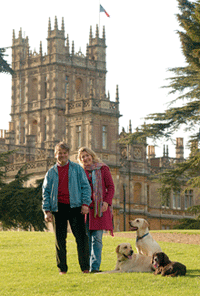
Lord George Herbert, 8th Earl of Carnarvon, and Lady Fiona,
8th Countess of Carnarvon.
©Highclere Castle Enterprises LLP 2013
|
Highclere is where much of Downton Abbey is filmed, and it is located one hour west of London on 6,000 acres of hills, meadows, lakes, pastures, and forests. The current Lord George Herbert and Lady Fiona, the 8th Earl and 8th Countess of Carnarvon, are the owners of this “new” 450-year-old English landmark that is now known throughout the world. The original manor house dated to the 18th century, but in 1842, the 3rd Earl of Carnarvon engaged Sir Charles Barry, the architect of the Houses of Parliament, to remodel Highclere as a mansion. He chose the distinctive golden-hue stone of Bath, England, for the outer walls, and tons were hauled 82 miles to the estate in carts pulled by oxen. The foundations for Highclere are said to be sixteen feet deep.
The ongoing theme of the tale of Downton Abbey is the preservation of the castle for future generations—the heir apparent to the castle goes down with the Titanic, the family fortune is lost in a risky investment, and a gigantic inheritance saves it from the auction block. Preservation is also the real-life theme today as the castle requires about $1 million per year for upkeep and day-to-day operations.
The show itself also comes with a hefty price tag. Each episode of Downton Abbey costs about £1 million to produce, but that is not a high price to pay for a series that is destined to become a classic. For antiquers and collectors, each episode should be viewed at least twice: once to be absorbed in the story, the characters and the costume, and a second time to observe the antiques in the background.
That said, there are many antiques not seen on Downton Abbey, such as a desk and chair that belonged to Napoleon Bonaparte. Lady Fiona, the 8th Countess of Carnarvon, graciously agreed to converse about the antiques of Highclere Castle, and as for Napoleon’s desk and chair, “It is not used in Downton,” she explained. “We remove it for safekeeping.”
|
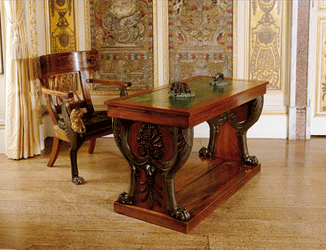
|
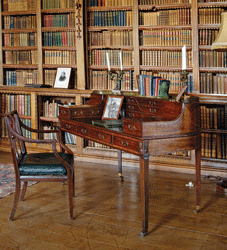
|
|
Napoleon took this desk and chair with him
in exile on St. Helena where he died.
©Highclere Castle Enterprises LLP 2013 |
This ca. 1780 George III Carlton House desk is in the Main Library and is used in the filming of Downton Abbey.
©Highclere Castle Enterprises LLP 2013
|
The green leather-topped desk and carved griffin-image chair were created by Jacob Frères, the furniture-making company of the brothers Georges II and François-Honoré Jacob from 1796 to 1803. Napoleon took the desk and chair with him into exile on the Island of St. Helena after his defeat at Waterloo.2 The pair was purchased by the 3rd Earl of Carnarvon in 1821 after Napoleon’s death that year. It has been suggested—but not by the Countess—that Napoleon may have used the desk for signing his abdication.
“I have no proof it was used for his abdication—it was made for him when he was Consul before he became Emperor, which allows us to date it. We have a sketch of Napoleon standing by the chair in the Chateau de les Tuileries.3”
One desk that is seen in Downton Abbey is a George III Carlton House Desk4 in the Main Library. Dated to circa 1780, Lord Grantham (Hugh Bonneville) and Matthew Crawley (Dan Stevens) both sit at it and write on it in several scenes.
“We use such furniture with care, and not often—we have our staff present throughout filming of every scene, agreeing what Hugh or Dan can do!”
The Carlton House Desk was named after the Prince of Wales’ residence in London. Prince George Augustus Frederick (1762-1830) was crowned King George IV after the death of his father George III.
In the State Dining Room, the painting of Charles I on horseback by Anthony Van Dyke, circa 1633 (Queen Elizabeth II also has this painting), dominates the room and overlooks the dining table. The painting has quite a tale about it. The masterpiece, which some value at £60 million today, was found on the estate some time after the death of Lord Protector Oliver Cromwell in 1658. It was rolled up and being used to prop open a barn door.
|
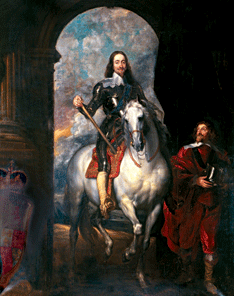
|
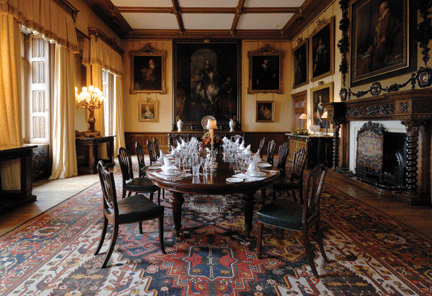
|
|
This portrait of Charles I by Van Dyke was found rolled up
and propping open a barn door after the time of Cromwell
in the late 1600s.
©Highclere Castle Enterprises LLP 2013
|
The State Dining Room is in the Stuart Revival style
of interior decoration. The painting of Charles I by
Van Dyke is on the far wall.
©Highclere Castle Enterprises LLP 2013
|
“Yes, that is the story! It was definitely best not to pay homage to Charles I during Cromwell’s reign; hence, it was taken down. I don’t know how much it is worth—it is simply outstanding.”
Cromwell was one of 59 signers to the death warrant of King Charles I after the Second Civil War in 1648. Yet, after the beheading, Cromwell allowed the king’s head to be sewn back onto his body before burial, out of respect for the family.
In the State Dining Room, there are also two other Van Dykes and several other 17th century paintings. With hundreds of paintings adorning the walls of this castle that has between 200 and 300 rooms, the Lady Carnarvon pays close attention to the display of the artwork, and she re-hangs paintings when necessary.
“I enjoy different portraits or works of art depending on my mood or knowledge. I carefully consider each piece and have re-hung quite a few paintings to give more coherence. For example, where one painting is an outstanding exercise in perspective, I have placed it so it can be better admired. I don’t like moving paintings for Downton as that hugely increases the risk of damage. We do remove all the china, however!”
Many of the walls of Highclere are adorned with antique wall coverings, such as those of the Saloon, the heart of Highclere. The Saloon’s walls display splendid 16th century, gold-embossed leather, brought from Spain in 1631 by the 3rd Earl. The Saloon is actually a three-story atrium, almost 100 feet high (30 meters), with skylights.
|
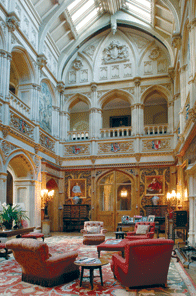
|
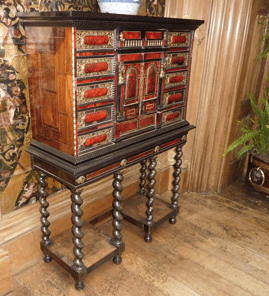
|
|
The Saloon is in a three-story atrium with skylights. Note the matching Dutch cabinets against the far wall.
|
One of a pair of Dutch cabinets in the Saloon.
All Saloon Photos ©Highclere Castle Enterprises LLP 2013
|
|

|

|
|
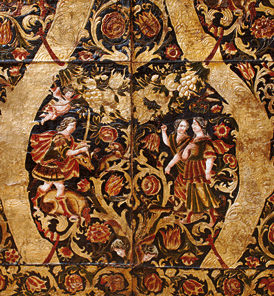
|
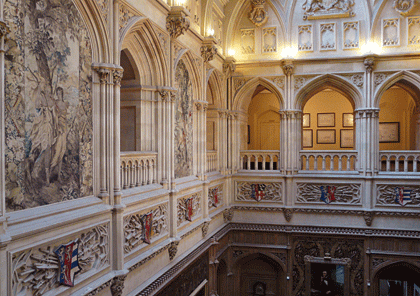
|
|
The embossed Spanish leather wall
coverings in the Saloon date from
1831 and were hung in 1862.
|
The Gallery above the Saloon with carved
alcoves, Belgian tapestries and the Heraldic crests
of the Carnarvon Family under the arches.
|
“They are part of Barry’s original plans, which we have in the archive room. We completed the restoration work on the lead around the skylights some eight years ago now.”
The Music Room features 16th century Italian embroideries and a baroque ceiling painted in the 1730s by Francis Hayman5.
Of particular note is a tapestry hanging near the bottom of the Great Oak Staircase.
“The tapestry is Belgian and 18th century. It depicts—along with its pair and six smaller ones—the story of Meleager6. I love the soft colors, the detail; although, they are so often just passed by as your eye is caught by something else—a Reynolds7 beneath one, for example.”
The Great Oak Staircase is itself a magnificent antique of the castle. It required nearly a year to carve and install, from December 1861 to October 1862.
|
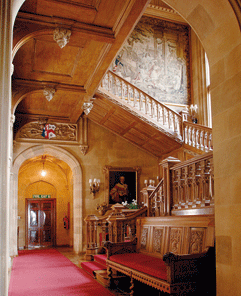
|
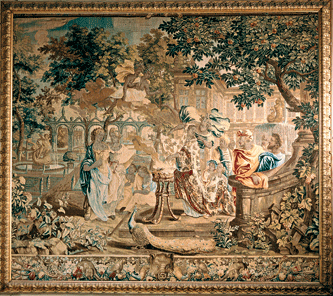
|
|
The Great Oak Staircase required a year to carve and install.
©Highclere Castle Enterprises LLP 2013
|
The Belgian 18th century Meleager Tapestry.
©Highclere Castle Enterprises LLP 2013
|
|

|

|
|
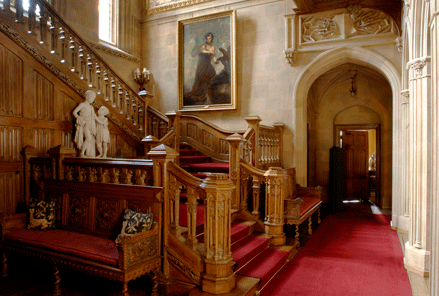
|
The Great Oak Staircase; the painting on the wall is Mrs. Musters as Hebe, Cupbearer to the Gods (1782) by Sir Joshua Reynolds, and above it (with just an edge showing) is where the Meleager Tapestry hangs.
©Highclere Castle Enterprises LLP 2013
|
About the china that the Countess safely stores during filming, some of those beautiful pieces were given to the Lady Almina, the 5th Countess of Carnarvon, by her father Alfred de Rothschild. In 1895, Almina married George Herbert, the 5th Earl of Carnarvon to become the 5th Countess. In Downton Abbey, it is a case of art imitating life as Lord Grantham married Cora (Elizabeth McGovern), an American heiress, to save the estate. The 5th Earl married Almina for the same reason—she was an English heiress to the Rothschild fortune who also brought a king’s-ransom dowry to the union.
The 5th Countess was quite a collector herself “…of several amazing pieces. Almina was very keen on French furniture and objets vertue,” including a Louis XVI bronze and ormolu candelabrum, among many other pieces.
The desire to collect seemed to be a family trait. Her husband was one of the greatest collectors in history, even though he is relatively unknown. Along with Howard Carter, the 5th Earl George Herbert was the co-discoverer of the Tomb of King Tutankhamen.
The Earl was an adventurer, and he spent many winters in Egypt searching for tombs and treasure. After several relatively fruitless expeditions, he teamed up with Howard Carter for other explorations. Together at Highclere, they planned their final trip to Egypt in 1922 which ended with the discovery of one of the greatest treasures in the world. Lady Almina’s fortune helped finance that expedition and others prior.
Less than five months after the Tomb of King Tut was opened, the 5th Earl was dead from an infected mosquito bite cut while shaving. His death helped fuel the myth of the “Mummy’s Curse” or the “Curse of the Pharaohs.”
|
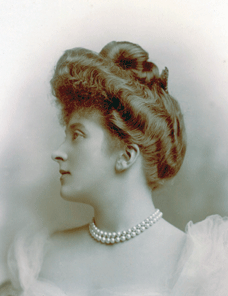
|
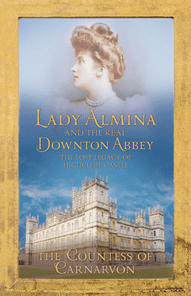
|
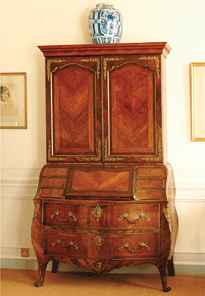
|
|
The Lady Almina,
the 5th Countess of
Carnarvon.
©Highclere Castle Enterprises LLP 2013
|
The 8th Countess of Carnavon's
book,
Lady Almna and the
Real Downton Abbey.
|
This bureau made of kingwood in 1765 by the French cabinet maker Pierre Langlois is probably one of
the rarest pieces of furniture in Highclere.
©Highclere Castle Enterprises LLP 2013
|
The Lady Fiona has written an engaging book about her predecessor Lady Almina entitled, Lady Almina And The Real Downton Abbey: The Lost Legacy of Highclere Castle. In it, she details many intriguing stories about the 5th Countess, her marriage at the age of 19 to the 29-year-old 5th Earl, how she set up Highclere as a hospital during WWI (as in Downton), and the Upstairs, Downstairs life of an Edwardian castle.
During his years in Egypt, the 5th Earl amassed an epic collection of artifacts. After his death, the Lady Almina was forced to sell much of it to pay the inheritance taxes.
Today, Highclere has an Egyptian Exhibition in the cellars, part of it in the original staff dining room (which is not where Carson, Mrs. Hughes, Mrs. Patmore, Anna, Mr. Bates, O’Brien, Daisy, Thomas, et al. are filmed—that location is on a movie set elsewhere).
|
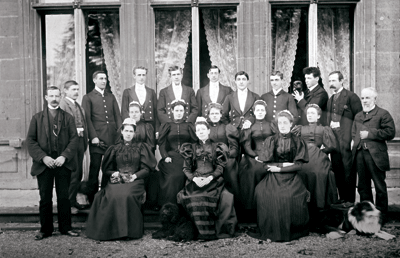
|
Some of the staff of Highclere Castle during the late Victorian Era. In those days, about 60 people would have worked at the estate, including house steward, butlers, footmen, housekeepers, maids, kitchen staff, hall and steward room boys, and many more.
©Highclere Castle Enterprises LLP 2013
|
|

|

|
|
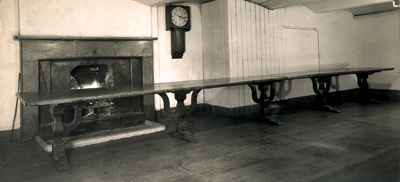
|
The staff dining room from that era.
Today, an Egyptian Exhibit is here.
©Highclere Castle Enterprises LLP 2013
|
The exhibit features a 3,500-year-old sarcophagus of a noblewoman, jewelry, pottery, hieroglyphic stones, carved stone sculptures, Ptolemaic coins, and many more artifacts. In an adventure of their own, some of the pieces in the exhibit were rediscovered by Lord and Lady Carnarvon hidden away in cupboards at Highclere.
Living among antiquities, masterpieces and antiques—including a library with 5,650 books, some dating to the 16th century—it is difficult to choose a favorite or two. However, when queried about the castle’s Georgian furniture in particular, the Countess replied, “I like the George Bullock side tables in the Dining Room—his workshop was behind the Carnarvon’s house in London. They are understated and demonstrate such a beautiful use of the wood.”
Like the previous earls and countesses, the Lord and Lady have increased the collection at Highclere.
“We have added to the Egyptian Exhibition—some beautiful carved animals, castanets and a Pre-Dynastic knife, for example. We have also added to the bedroom paintings and carpets and rugs. I have commissioned new rugs and moved some others around in order to find rooms where they will be less worn, which then changes the colors and spaces in the rooms.”
Preserving Highclere for future generations is a priority for the Lord and Lady. In addition to the overall upkeep of the castle and the estate, they also pay great attention to the details, whether it is moving china for safekeeping during filming or restoring textiles.
|
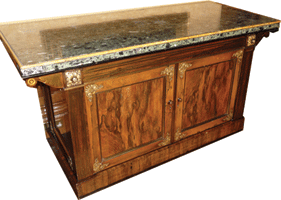
|
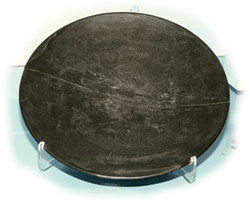
|
|
A George Bullock side table in the Dining Room.
©Highclere Castle Enterprises LLP 2013
|
A schist dish of carved stone from ancient Egypt.
©Highclere Castle Enterprises LLP 2013
|
“We have some fire screens, but we move them out from the filming. Some exceptional chairs are now displayed in a bedroom away from the filming. I find the care and preservation of fabrics and textiles one of the most challenging areas, requiring very careful decisions and the expertise of help, which is usually hard to find.”
For the Countess, the challenges of Highclere Castle are many, but they are balanced with ongoing rewards.
“I most enjoy the timeline that runs through Highclere—with a schist8 dish from 5,000 B.C. to the wall covering in the Saloon, an Agra Carpet, or a small charming Landseer 9 portrait. I am utterly focused on Highclere on understanding the past, on making it fascinating today and thereby giving it a future. That is my passion. Downton has obviously been great marketing.”
|
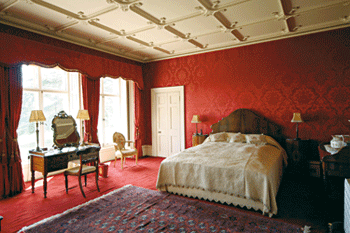
|
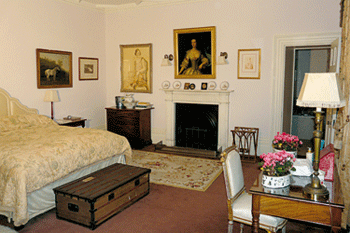
|
|
The Stanhope Bedroom was decorated in red for the visit of the Prince of Wales in 1895. There are 50-60 bedrooms in Highclere.
©Highclere Castle Enterprises LLP 2013
|
This bedroom was used as an
operating room
during World War I.
©Highclere Castle Enterprises LLP 2013
|
It is estimated that more than 1,000 of the manor homes and mansions in England have been demolished since 190010. In the 1950s and 1960s, many were destroyed rather than pay the inheritance taxes (as high as fifty to eighty percent), and social attitudes about serving in a manor had changed.
Virtually all of those old homes and castles held important collections of antiques and artwork—some had world-class collections—which were sold off or dispersed, often leaving the country. Fortunately, the Lord and Lady of Carnarvon have remained steadfast in preserving the art and antiques of Highclere Castle, which are now being enjoyed by the world.
---------------------------------------------
Today, Highclere is a working castle that is open to the public for tours, weddings, private dining and corporate events. When traveling to England, it must be added to the itinerary. Highclere Castle is closed during the winter, and it is not open every day during the other seasons, so check the website (www.highclerecastle.co.uk) for dates, to pre-book tickets and to learn more about Highclere.
The 8th Countess’ book, Lady Almina And The Real Downton Abbey: The Lost Legacy of Highclere Castle, is available on Amazon.com.
All photos, unless otherwise noted, © Highclere Castle Enterprises LLP 2013.
1 Sixty Minutes, interview with Steve Kroft, broadcasted on February 17, 2013.
2 Napoleon was first exiled to the Island of Elba off the Tuscan coast of Italy before escaping and returning to
power. St. Helena is an island in the Atlantic Ocean 1,200 miles west of Africa.
3 Chateau de les Tuileries, also known as the Palace Tuileries, was the residence of royalty in Paris, including
Louis XIV, Louis XV, Louis XVI, Napoleon, Napoleon III and others. Constructed in 1564, it was
destroyed by revolutionaries by arson in 1871; it burned for two days. Its facade was about 291 yards in
length. Tuileries means tilery, or a factory or kiln for making tile, which existed there before the palace.
4 A similar Carlton House Desk, circa 1790, was auctioned by Christie’s in 2008 for approximately $60,000.
5 The artist Francis Hayman (1708–1776) was a founding member of the Royal Academy of Arts.
6 In mythology, Meleager was one of the Argonauts and was considered second only to Heracles in prowess.
At birth, the Fates foretold he would die after a certain piece of wood in the fireplace burned completely.
His mother extinguished the stick and hid it. Later in life, Meleager killed his mother’s brothers in an
argument over a prized boar skin. She retrieved the stick and burned it, ending her son’s life.
7 Sir Joshua Reynolds was a portrait painter knighted by King George III and a founder and president of the
Royal Academy of Arts.
8 Schist is a metamorphic stone, usually of mica, that is easily split and carved into dishes or disks. The schist
dish at Highclere is from Egypt.
9 Sir Edwin Henry Landseer (1802–1873) was a member of the Royal Academy of Arts and is known for his
paintings of animals and his lion sculptures at the base of Nelson’s Column in Trafalgar Square.
10 Giles Worsley, England's Lost Houses, Aurum Press (available at Amazon.com).
More photos of people and artists mentioned in the article, past staff members, and rooms in Highclere.
|
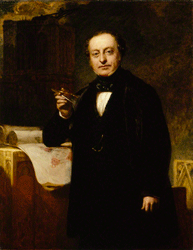
|
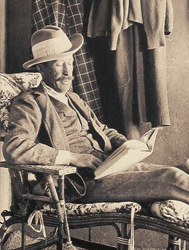
|
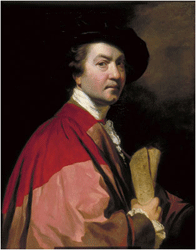
|
|
“Sir Charles Barry,” circa 1851, by John Prescott Knight (1803-1881). Sir Charles was the architect of Highclere Castle.
|
George Herbert, 5th Earl of Carnarvon,
one of the discoverers of King Tutankhamen’s Tomb.
|
Sir Joshua Reynolds (1723-1792) painted
Mrs. Musters as Hebe, Cupbearer to the Gods that
hangs near the landing of the Great Oak Staircase
and this self portrait (1782).
|
|
| 
|
|
|
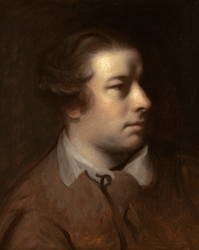
|
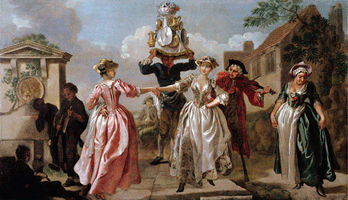
|
|
A portrait of Francis Hayman (1708-1776) by
Sir Joshua Reynolds in the 1760s. Hayman painted
the baroque ceiling in the Music Room in the 1730s.
|
“Milkmaids Dancing,” circa 1735, is in the Victoria and Albert Museum in London and is an example of the work of Francis Hayman.
|
|
| 
|
|
|
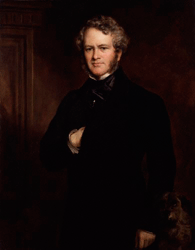
|
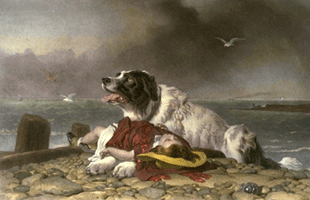
|
|
“Sir Edwin Henry Landseer” by Sir Francis Grant (1803-1878).
|
“Saved” (1856) is an example of Sir Edwin Henry Landseer’s (1802-1873) work showing his great ability to paint animals.
|
|
| 
|
|
|
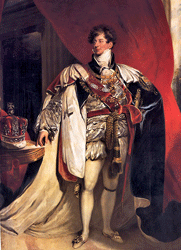
|
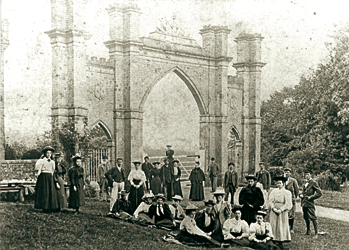
|
|
“The Prince Regent,” by Thomas Lawrence (1769-1830) is George Augustus Frederick (1762-1830) who served as Prince Regent during his father George III’s mental illness. He was crowned King George IV at his father’s passing. The Carlton House Desk was named after his residence as Prince Regent.
|
The staff of Highclere on an outing.
©Highclere Castle Enterprises LLP 2013
|
|
|